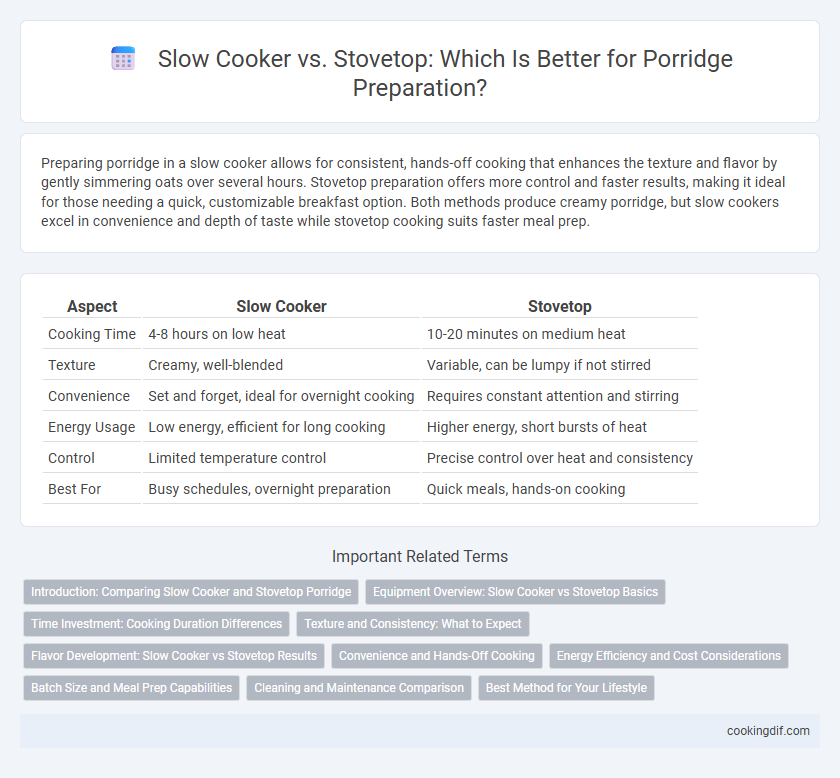Preparing porridge in a slow cooker allows for consistent, hands-off cooking that enhances the texture and flavor by gently simmering oats over several hours. Stovetop preparation offers more control and faster results, making it ideal for those needing a quick, customizable breakfast option. Both methods produce creamy porridge, but slow cookers excel in convenience and depth of taste while stovetop cooking suits faster meal prep.
Table of Comparison
| Aspect | Slow Cooker | Stovetop |
|---|---|---|
| Cooking Time | 4-8 hours on low heat | 10-20 minutes on medium heat |
| Texture | Creamy, well-blended | Variable, can be lumpy if not stirred |
| Convenience | Set and forget, ideal for overnight cooking | Requires constant attention and stirring |
| Energy Usage | Low energy, efficient for long cooking | Higher energy, short bursts of heat |
| Control | Limited temperature control | Precise control over heat and consistency |
| Best For | Busy schedules, overnight preparation | Quick meals, hands-on cooking |
Introduction: Comparing Slow Cooker and Stovetop Porridge
Slow cooker porridge offers consistent low heat that enhances texture and allows convenient overnight preparation, reducing morning effort. Stovetop porridge provides rapid heat control for faster cooking but requires constant attention to prevent sticking or burning. Each method suits different lifestyles, with slow cookers ideal for hands-off cooking and stovetop preferred for quick, customizable results.
Equipment Overview: Slow Cooker vs Stovetop Basics
A slow cooker offers consistent low heat ideal for overnight porridge, enhancing creaminess and flavor development with minimal attention. In contrast, stovetop cooking provides quicker temperature control, allowing precise texture adjustments but requires constant monitoring to prevent burning. Choosing between these depends on convenience preference and desired porridge texture refinement.
Time Investment: Cooking Duration Differences
Slow cookers require significantly longer cooking times for porridge, often ranging from 4 to 8 hours, allowing grains to absorb liquid slowly for a creamy texture. Stovetop methods cook porridge much faster, typically within 10 to 30 minutes, offering quick preparation but demanding constant attention to prevent burning. Choosing between the two depends on available preparation time and desired texture consistency.
Texture and Consistency: What to Expect
Slow cooker porridge offers a creamy, smooth texture due to its low and steady heat, allowing grains to fully absorb liquid and soften evenly over several hours. Stovetop porridge provides more control over consistency, enabling adjustments for thicker or thinner results with shorter cooking times, but may require frequent stirring to avoid clumping or burning. Expect slow cooker porridge to have a uniform, velvety finish, while stovetop methods yield a variable texture based on stirring and heat management.
Flavor Development: Slow Cooker vs Stovetop Results
Slow cookers enhance porridge flavor by allowing ingredients to meld over extended, low-heat cooking times, resulting in deeper, richer taste profiles. Stovetop preparation offers quicker cooking but may produce less complex flavors due to higher temperatures and shorter simmering. Slow cooking preserves aromatic compounds and promotes Maillard reactions at lower heat, intensifying porridge's natural sweetness and creaminess.
Convenience and Hands-Off Cooking
Slow cookers offer unmatched convenience for porridge preparation by allowing extended, low-temperature cooking without constant supervision, freeing up time for other activities. Stovetop methods require more attentive stirring and temperature adjustments to prevent burning or sticking, demanding hands-on effort throughout the cooking process. Choosing a slow cooker enhances hands-off cooking, ideal for busy mornings or overnight preparation.
Energy Efficiency and Cost Considerations
Slow cookers generally use less energy compared to stovetop methods because they maintain a low, consistent temperature over longer periods, reducing overall electricity consumption. Stovetop porridge preparation typically requires higher heat and closer monitoring, leading to increased gas or electric usage and potentially higher utility costs. Choosing a slow cooker can lower energy bills and provide cost-effective, convenient porridge cooking without sacrificing texture or flavor.
Batch Size and Meal Prep Capabilities
Slow cookers excel in preparing large batches of porridge, allowing families to have multiple servings ready for the week, enhancing meal prep efficiency. Stovetop methods offer more flexibility for small batches but require constant attention, making them less ideal for bulk preparation. Choosing a slow cooker optimizes time management and batch size, streamlining porridge meal planning for busy schedules.
Cleaning and Maintenance Comparison
Slow cookers for porridge preparation typically feature non-stick ceramic or stainless steel inserts that are dishwasher-safe, simplifying cleaning processes and reducing manual effort. Stovetop pots, often made of stainless steel or cast iron, require thorough scrubbing to remove stubborn porridge residue and may require seasoning, especially for cast iron, increasing maintenance time. Slow cookers offer the advantage of fewer components and less intensive cleaning routines, while stovetop methods demand more detailed care to maintain pot integrity and performance over time.
Best Method for Your Lifestyle
Slow cookers offer a hands-off approach, perfect for busy schedules, allowing porridge to cook gradually overnight for a creamy texture. Stovetop preparation provides greater control over consistency and cooking time, ideal for those who prefer adjusting heat and stirring frequently. Choosing between slow cooker and stovetop depends on your time availability and desired porridge texture, aligning with your lifestyle needs.
Slow cooker vs Stovetop for porridge preparation Infographic

 cookingdif.com
cookingdif.com